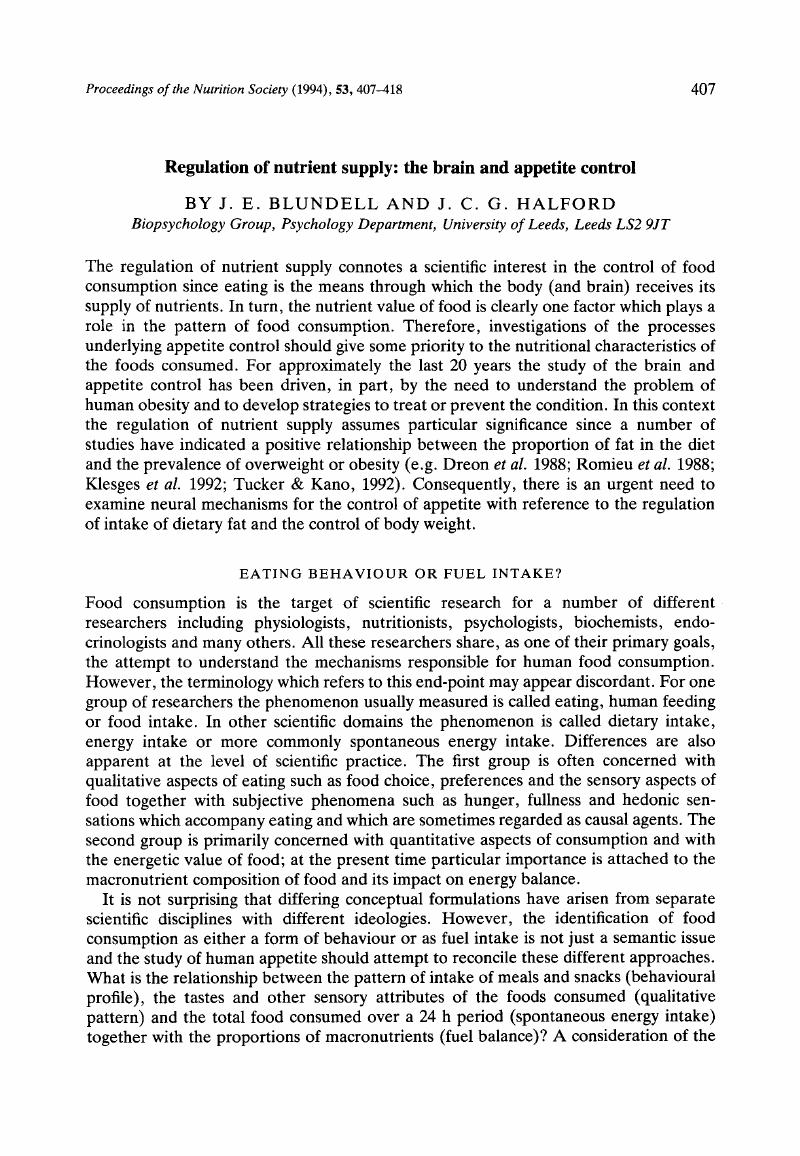Crossref Citations
This article has been cited by the following publications. This list is generated based on data provided by Crossref.
Eastwood, Martin
1997.
Principles of Human Nutrition.
p.
309.
Imbeault, Pascal
Saint-Pierre, Sylvie
AlméRas, Natalie
and
Tremblay, Angelo
1997.
Acute effects of exercise on energy intake and feeding behaviour.
British Journal of Nutrition,
Vol. 77,
Issue. 4,
p.
511.
Goldberg, Gail R.
Murgatroyd, Peter R.
McKenna, Aideen P. M.
Heavey, Patricia M.
and
Prentice, Andrew M.
1998.
Dietary compensation in response to covert imposition of negative energy balance by removal of fat or carbohydrate.
British Journal of Nutrition,
Vol. 80,
Issue. 2,
p.
141.
Owen, John B
1999.
Genetic aspects of body composition.
Nutrition,
Vol. 15,
Issue. 7-8,
p.
609.
Vozzo, Rosalie
Wittert, Gary A
Chapman, Ian M
Fraser, Robert
Hope, Perdita J
Horowitz, Michael
Alshaher, Motaz M
Kumar, Vijaya B
and
Morley, John E
1999.
Evidence that nitric oxide stimulates feeding in the marsupial Sminthopsis crassicaudata.
Comparative Biochemistry and Physiology Part C: Pharmacology, Toxicology and Endocrinology,
Vol. 123,
Issue. 2,
p.
145.
Spyrou, N. M.
1999.
Neutron activation analysis challenges: Problems and applications in biomedical and other areas.
Journal of Radioanalytical and Nuclear Chemistry,
Vol. 239,
Issue. 1,
p.
59.
MacIntosh, Caroline
Morley, John E
and
Chapman, Ian M
2000.
The anorexia of aging.
Nutrition,
Vol. 16,
Issue. 10,
p.
983.
Tuomisto, Jouni T
Viluksela, Matti
Pohjanvirta, Raimo
and
Tuomisto, Jouko
2000.
Changes in Food Intake and Food Selection in Rats After 2,3,7,8-Tetrachlorodibenzo-p-dioxin (TCDD) Exposure.
Pharmacology Biochemistry and Behavior,
Vol. 65,
Issue. 3,
p.
381.
McCarthy, Donna O.
2000.
Cytokines and the Anorexia of Infection: Potential Mechanisms and Treatments.
Biological Research For Nursing,
Vol. 1,
Issue. 4,
p.
287.
Carter, Chris
Houlihan, Dominic
Kiessling, Anders
Médale, Francoise
and
Jobling, Malcolm
2001.
Food Intake in Fish.
p.
297.
van Nieuwenhoven, Michiel A.
Kovacs, Eva M.R.
Brummer, Robert-Jan M.
Westerterp-Plantenga, Margriet S.
and
Brouns, Fred
2001.
The Effect of Different Dosages of Guar Gum on Gastric Emptying and Small Intestinal Transit of a Consumed Semisolid Meal.
Journal of the American College of Nutrition,
Vol. 20,
Issue. 1,
p.
87.
Wright, Mark J.
Woodrow, Graham
O'Brien, Siobhan
King, Neil A.
Dye, Louise
Blundell, John E.
Brownjohn, Aleck M.
and
Turney, John H.
2001.
A novel technique to demonstrate disturbed appetite profiles in haemodialysis patients.
Nephrology Dialysis Transplantation,
Vol. 16,
Issue. 7,
p.
1424.
Wright, Mark
Woodrow, Graham
O'Brien, Siobahn
King, Neil
Dye, Louise
Blundell, John
Brownjohn, Aleck
and
Turney, John
2003.
Disturbed Appetite Patterns and Nutrient Intake in Peritoneal Dialysis Patients.
Peritoneal Dialysis International: Journal of the International Society for Peritoneal Dialysis,
Vol. 23,
Issue. 6,
p.
550.
Wright, M.
Woodrow, G.
O'Brien, S.
Armstrong, E.
King, N.
Dye, L.
Blundell, J.
Brownjohn, A.
and
Turney, J.
2004.
Cholecystokinin and leptin: their influence upon the eating behaviour and nutrient intake of dialysis patients.
Nephrology Dialysis Transplantation,
Vol. 19,
Issue. 1,
p.
133.
Blundell, John E.
Finlayson, Graham
and
Halford, Jason
2005.
Clinical Obesity in Adults and Children.
p.
137.
Lentle, R. G.
Hume, I. D.
Stafford, K. J.
Kennedy, M.
Springett, B. P.
and
Haslett, S.
2005.
The temporal organisation of the feeding behaviour of four species of wallaby: examining chronobiological and homeostatic influences.
Australian Journal of Zoology,
Vol. 53,
Issue. 2,
p.
117.
2006.
Nutrition and the Eye.
p.
43.
Arora, Sarika
and
Anubhuti
2006.
Role of neuropeptides in appetite regulation and obesity – A review.
Neuropeptides,
Vol. 40,
Issue. 6,
p.
375.
Preston, R.L.
2007.
Receiving Cattle Nutrition.
Veterinary Clinics of North America: Food Animal Practice,
Vol. 23,
Issue. 2,
p.
193.
King, Neil A.
Caudwell, Phillipa
Hopkins, Mark
Byrne, Nuala M.
Colley, Rachel
Hills, Andrew P.
Stubbs, James R.
and
Blundell, John E.
2007.
Metabolic and Behavioral Compensatory Responses to Exercise Interventions: Barriers to Weight Loss.
Obesity,
Vol. 15,
Issue. 6,
p.
1373.



